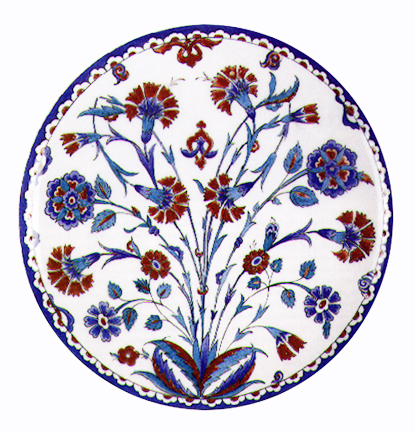
Plate, Earthenware with underglaze cobalt
and overglaze 'Armenian Bole' decoration
Ottoman Turk, Iznik, 1580 CE, 13" diameter
ART 198 - HISTORY OF WORLD CERAMICS
| The most famous of the pottery produced under the Ottoman Turkish empire is called Iznik, after the city in which it was produced. Showing the influence of Ming blue and white porcelain, this pottery expanded the color palette by using overglaze enamels.. These platters, of which there is an excellent collection at the Victoria and Albert Museum in London, were mainly ornamental, and often were quite large, up to 36" in diameter. The pottery center at Iznik was primarily involved with the production of tile used to construct and repair mosques, madrasas, and palaces. However, in the odd spaces of the kilns, plates, vases, and flasks were also fired. This example shows how the Iznik potters were able to introduce the elusive red into the color palette. Turquoise and blue have never been difficult for the potter, but red has always been difficult, as it still is today. Using a compound called 'Armenian Bole,' an iron bearing clay, and firing in an oxidizing atmosphere, they were able to get rather consistent reds, although contemporary chroniclers did note its 'elusive' qualities. Still unknown to the potters of the Middle East was the secret of porcelain, and the Iznik potters used a white earthenware to create the white background necessary for such decoration. | Plate, Earthenware with underglaze cobalt and overglaze 'Armenian Bole' decoration Ottoman Turk, Iznik, 1580 CE, 13" diameter |
|
|